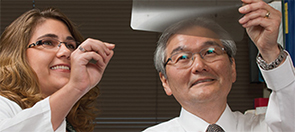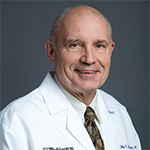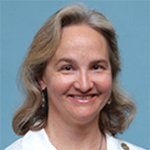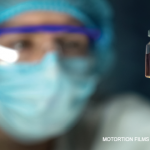
Dr. Yokoyama, MD, with Jennifer Laurent
In June 2014, 10 members of a church group returned to St. Louis from Haiti, where they had contracted chikungunya virus (CHIKV), a mosquito-transmitted alphavirus previously unknown in the Western hemisphere that produces inflammatory arthritis symptoms. Because CHIKV-related arthritis mimics seronegative RA, a group of clinicians, immunologists, virologists and geneticists at the Washington University in St. Louis Division of Rheumatology saw this cohort of patients as a unique opportunity. They assessed the patients’ clinical symptoms, laboratory features and immune cell phenotypes using cytometry by time of flight and compared them with healthy controls and patients with active RA. In their brief report, the authors report that they found that CHIKV-related arthritis is highly similar to RA, both in terms of clinical manifestations and laboratory features. They highlighted the need to consider patients’ travel histories when evaluating patients with symmetric polyarthritis.1

Dr. Atkinson
This interdisciplinary collaboration exemplifies the division’s strengths, says John P. Atkinson, MD, Samuel B. Grant Professor of Medicine, professor of molecular microbiology and chief of the Division of Rheumatology. With robust ties to the Departments of Pathology and Immunology, Molecular Microbiology and divisions in the School of Medicine, the rheumatology research program has advanced our understanding of the pathogenesis of multiple inflammatory diseases in its 53-year history.
Boasting premier research scientists—five of whom are or have been Howard Hughes Medical Institute Investigators, numerous former fellows and faculty who now head rheumatology divisions at their own institutions and a majority of faculty members who hold double appointments in research—the Division of Rheumatology continues to build on a foundation of scientific and clinical excellence.
The Beginnings

Dr. Parks
It was in 1962, according to a lively historical summary on the division’s website, that the division got its start. C. Kirk Osterland, MD, was charged with establishing the research/academic branch of the division within the Department of Medicine and Preventive Medicine. Robert Karsh, MD, took the reins of the clinical branch, joining the staff of Barnes [now Barnes Jewish] Hospital. (“Dr. Karsh is still active in academics and contributes to our Rheumatology Grand Rounds,” notes Dr. Atkinson.) Notable rheumatologists, including Bevra Hahn, MD, Benjamin D. Schwartz, MD, PhD, and Eng Tan, MD, spent their training and early faculty years there.
Strong collaborations with other Wash U divisions and the university’s remarkable tradition of basic science research augmented the division’s progress in building its

